Driving along a country road here in Pennsylvania you’re likely to see many a roadside weed. Weeds like Queen Anne’s Lace or wild carrot, chicory and goldenrods are flowering everywhere. These weeds are wildflowers to me, but to others they are nothing more than weeds in a field.
My definition of a weed is a plant that grows where you don’t want it to grow. So, by definition, a rose bush could be a weed. These roadside “weeds” are growing right where they’re supposed to grow.
A new wildflower for me is a pretty, four-petaled white blossom called Virgin’s Bower. It’s a vine that grows alongside of Jewelweed, New York Ironweed, Joe-Pye weeds, brambles and thistles.
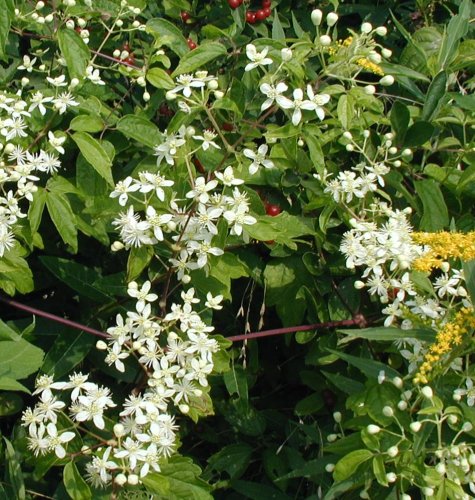
Virgin’s Bower flowering along a country road in Pennsylvania.
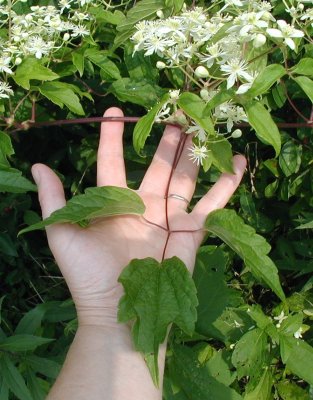
Compound leaves of Virgin’s Bower, Clematis virginiana, are strongly toothed, in threes and may have purple stems.
Classified as a non-woody vine Virgin’s Bower climbs over brush and, in sunny moist locations, it practically coats roadside vegetation with clusters of white flowers.
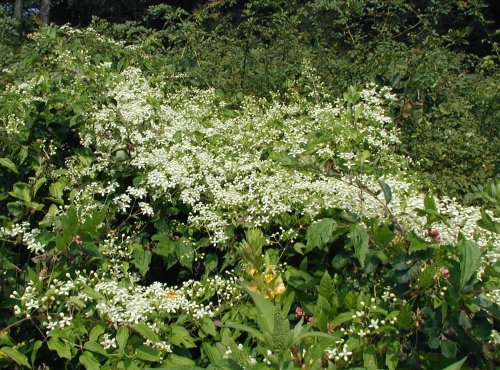
Virgin’s Bower grows like a vine over and on top of other vegetation.
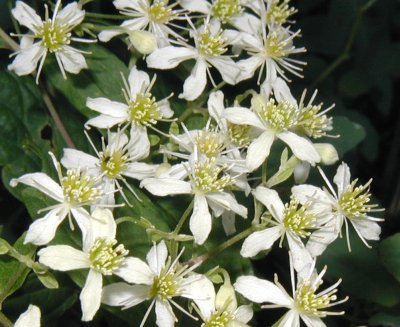
Flowers consist of 4 white, petal-like sepals and many white stamens in clusters in the leaf axils.
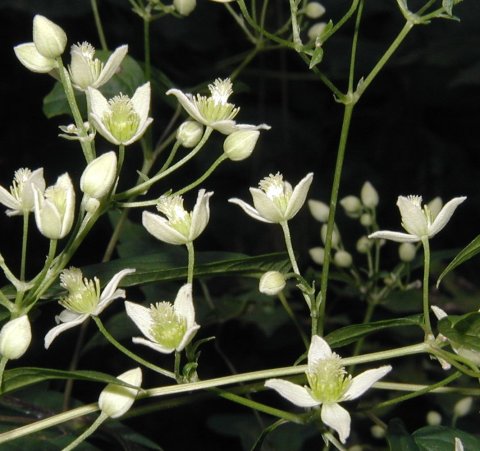
Young flowers of Virgin’s Bower just starting to open up.
As with most members of the Buttercup family, Ranunculaceae, Virgin’s Bower contains toxic compounds. Be careful handling Virgin’s Bower as contact can be highly irritating to skin and mucous membranes. Even though the whole plant was used in liniments in the past, some people are sensitive to it. Consuming it may produce upper and lower gastrointestinal upsets and even convulsions.
Anyone having Clematis plants in their garden may recognize the fruit of this native clematis species. Virgin’s Bower fruit has the creative name of ‘Old Man’s Beard’ due to the scraggly appearance of gray, feathery plumes which are attached to the seeds of the female plant.
What do the seeds of the male plant look like? How can you tell the female plants from the male plants at other times of the year?
Keep observing and we’ll learn about it – all in due time, My Pretty!
Beautiful plant and your description is great. I have just begun to propagate and grow this plant. I think it has a lot of garden potential.
Hi Ellen!
I look forward to seeing the Virgin’s Bower blooming and it’s going strong right now in PA. Wouldn’t it look great climbing up a trellis? I think it has a lot of potential for a native garden, too. Good luck in your efforts!
Let us know how it goes!
Although very beautiful, I recommend against planting this vine intentionally. We have it on our property and it is a very formible weed. Almost impossible to uproot without a shovel, fast spreading by root and seed, and extremely fast growing it tends to smother out everything else. Admire it on the roadside!
Great write-up though.
It’s always great to hear first-hand knowledge about how these plants really live. When you see Virgin’s Bower on the roadside it often does look like it’s covered the tops of whatever plants or objects it vines upon. You can easily see how the underneath plants could be blotted out.
Thanks for chiming in, Lloyd. Sounds like great advice!
Thanks for the information — especially about the toxicity. This is growing in the back yard of the house I moved into in the spring. It grew all over the azalea and I was wondering if I should try to remove it. As I am very susceptible to plant toxins, I will wear gloves and long sleeves!
Hi Penny,
You’re welcome. The azalea bush will probably appreciate it! Good luck in your removal efforts. Let us know how stubborn the plant is. Do you think it will return in the spring if you rip it out now?
Let us know!
This is so invasive and difficult to remove that I urge you to NOT propagate it. Not only am I fighting to save my lilac and weigela but I think I am allergic or reacting to it (right outside of my open window!).
Thanks for your advice, Emily.
I just purchased an old home in Vancouver WA and this vine has literally taken over an entire fence, grown up into a lovely conifer which it threatens to overpower, and it invades any small crack in a structure (which it has done to a shed near the fence). It is in bloom now and the flowers are lovely but definitely not worth the nuisance. I would NEVER plant this invasive monster on purpose.
Thanks for putting in your 2cents, Linda. Where ever I see it along the roads in the county, the virgin’s bower really does appear to cover over other plants very well as if it’s a carpet draped over them. We’ll leave it by the road and appreciate it from there.
I’m so glad I looked at your site! I live in Michigan and my neighbor has this vine growing and I admired it and thought it would be nice on a trellis. It grows over the neighbor’s fence and over my blue spruce trees annually and I remove it annually. Now that I know more about it, I will look for other, less invasive options.
Good on ya’, Nancy!
Thanks for the information. I have this vine, someone gave it to me, and I like the flowers, but I did not know it was toxic. I have it in containers, so I hope it does not take over. Maybe I will just
take it to my property in the country and plant it there.
I live in Avignon, Provence, South of France & on my daily walks with my dog I saw this delicate looking flower, smart and subtle enough to be added to Wedding bouquets…
First I noticed it creeping onto a wire mesh fence, it looked gorgeous and it also crept from under the fence onto a path, but it had been cut away.
I was sad not to see it again until the other day – these delicate white flowers are back!
Reading the above posts here I am glad it isn’t in my garden, but someone else’s …
They are subtle, sweet flowers. Nice observations, Alexandra.
I think nearly the same thing every time I see Morning Glorys on someone else’s property. If ever you want to get rid of them, well good luck. Once they’re present, you’ve got them!